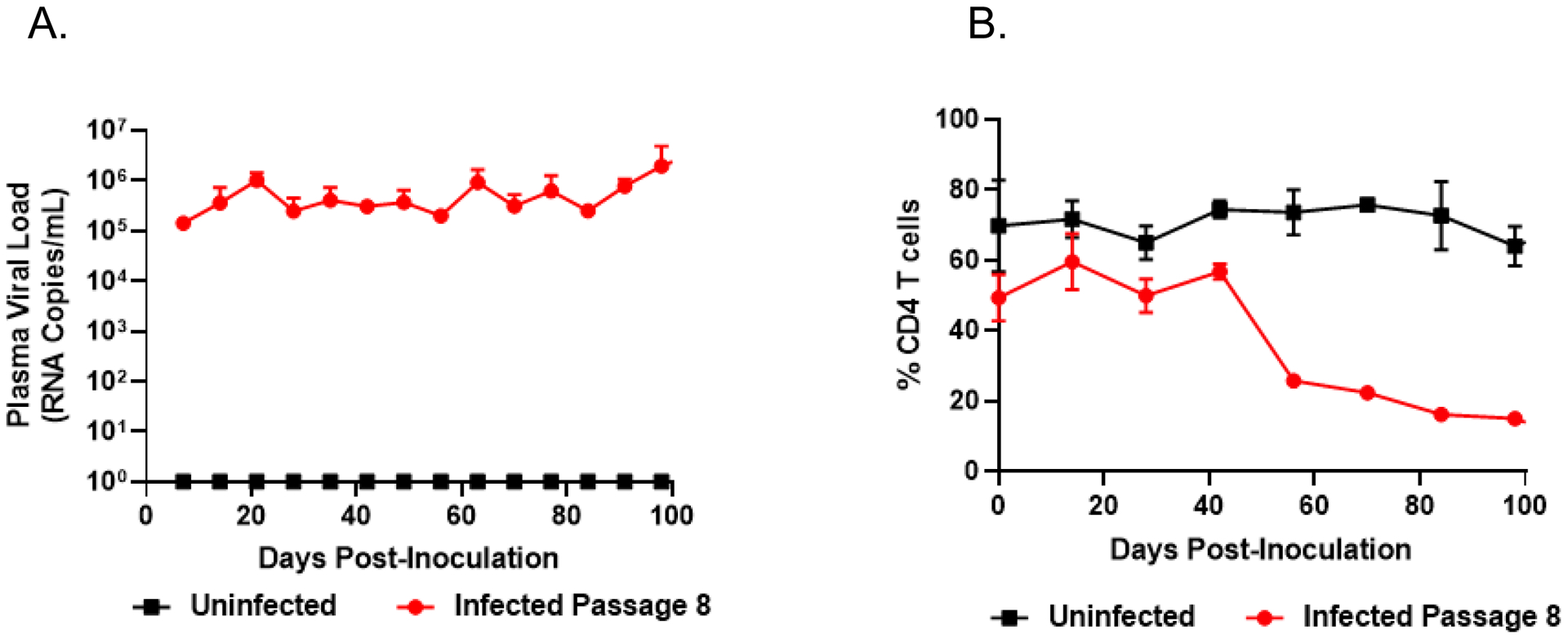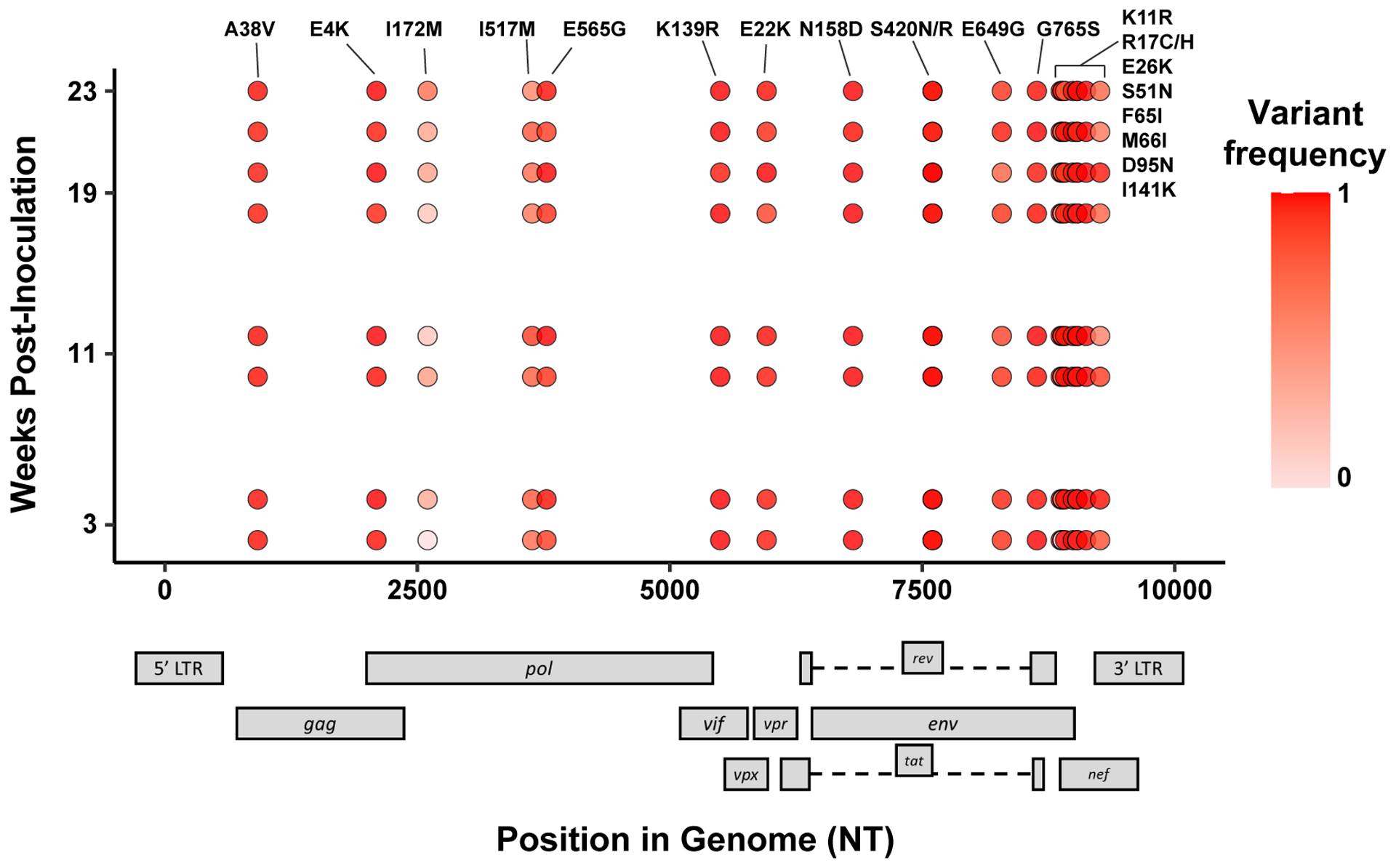Abstract
Through the accumulation of adaptive mutations, HIV-2 originated from SIVsm. To identify these evolutionary changes, a humanized mouse model recapitulated the process that likely enabled this cross-species transmission event. Various adaptive mutations arose, as well as increased virulence and CD4+ T-cell decline as the virus was passaged in humanized mice.
Keywords: HIV-2 viral evolution, SIVsm evolution towards HIV-2, Sooty Mangabeys, cross-species SIV transmission, SIVsm infection in humanized mice, hu-HSC mice for viral cross-species jump
2. INTRODUCTION
SIV sooty mangabey (SIVsm) is believed to have accumulated a number of genetic changes during cross-species transmission events between humans and sooty mangabeys that eventually resulted in HIV-2.1–3 Humanized hematopoietic stem cell (Hu-HSC) mice are an effective model to study this question, as they provide an in vivo human immune environment that mimics the selective pressures of natural human infections.4–11 Here, we used serial passaging to simulate the repeated cross-species exposures of SIVsm and reproduce the mutations that likely facilitated the transition of SIVsm into HIV-2.12–14 Following the inoculation of hu-mice, SIVsmE041 was sequentially passaged for eight generations. Mice were assessed weekly for plasma viral loads and CD4+ T-cell decline was monitored biweekly to determine viral pathogenicity over time. Additionally, the adapted virus was sequenced using Illumina-based deep sequencing to identify mutations that potentially played role in SIVsmE041 adaption to human cells for higher viral fitness.
3. MATERIALS AND METHODS
3.1. Hu-HSC mouse preparation and Ethics
Humanized hu-HSC mice were prepared as previously described.15–19 Experimental animals were maintained at the Colorado State University Painter Animal Center. All studies were approved and reviewed by the CSU Institutional Animal Center and Use Committee.
3.2. SIVsmE041 infection of hu-HSC mice and serial passaging
SIVsmE041 (GenBank accession HM059825.1), isolated from sooty mangabey PBMC, was used to infect hu-HSC mice as previously described.9,10 Approximately 24 weeks after inoculation, mice with the highest plasma viral loads were euthanized to propagate the virus as previously described.6,9,10 This process was repeated for 8 sequential passages.
3.3. CD4+ T-cell decline and plasma viral load detection
Peripheral blood was collected weekly by tail vein puncture and viral RNA was isolated from plasma using the E.Z.N.A Viral RNA kit (Omega bio-tek, Norcross, CA). RNA was quantified using qRT-PCR and SYBR Green with the iScript One-Step RT-PCR kit (BioRad, Hercules, CA) according to the manufacturer’s instructions to determine plasma viral loads. Bimonthly, whole blood collected from the mice was stained with mouse anti-human CD45-APC (eBioscience), CD3-FITC (eBioscience), and CD4-PE (BD Pharmingen, San Jose, CA) antibodies. CD4+ T-cell levels were assessed as a percentage of CD45+/CD3+ cells with the BD Accuri C6 cytometer as described previously.6,9,10 Comparison of CD4+ T-cell decline between control and infected mice was assessed with a two-tailed Student’s t-test. (p<0.001)
3.4. SNP detection and Illumina-based deep sequencing
Viral RNA from two infected mice at weeks 3, 11, 19, and 23 post-infection in the eighth passage were used to generate amplicons with primers designed using Primal Scheme software.20 Amplicons were prepared using the TruSeq Nano DNA Library Preparation Kit and the MiSeq Illumina desktop sequencer (Invitrogen, Carlsbad, CA). Nonsynonymous SNPs were identified by aligning reads to the SIVsm stock virus consensus sequence using bowtie2 software v2.2.5, and then calling variants at >100 coverage depth and >1% frequency using lofreq software v2.1.2.21,22 Genome plots were generated using R and ggplot2 (ISBN: 0387981403). R scripts can be found at https://github.com/stenglein-lab/viral_variant_explorer
4. RESULTS
Eight serial passages in hu-mice resulted in a human adapted SIVsmE041 capable of rapid infection within one week of inoculation that was sustained for over 100 days and maintained above 105 RNA copies/ml (Figure 1A). CD4+ T-cell levels showed significant (p<0.001) decline that commenced around 60 days post-inoculation and persisted through the remainder of the passage (Figure 1B). This is a markedly drastic decline compared to earlier passages with SIVsm in humanized mice. Numerous nonsynonymous single nucleotide polymorphisms (SNPs) were identified using Illumina-based deep sequencing throughout the viral genome at high frequencies (Figure 2).
Figure 1. Plasma Viral Loads and CD4+ T-cell decline following eight serial passages of SIVsmE041 in hu-HSC mice.

(A) Plasma viral loads collected from the eighth passage of SIVsmE041 infected mice (B) CD4+ T-cell depletion following SIVsmE041 infection. CD4+ T cell depletion was rapid and significant within 60 days post-inoculation (two-tailed Student’s t-test, p<0.001).
Figure 2. SNP frequencies identified after eight serial passages in hu-HSC mice that reached >50% of the viral population at the last timepoint.

Lofreq v2.1.2 was used to identify SNP frequencies following read alignment by bowtie2 v2.2.5. Mutations were present throughout the genome, with the highest concentration in env and nef.
5. DISCUSSION
Serial passaging in humanized mice provided an effective model for recapitulating the genetic changes that allowed SIVsm to adapt to human immune cells similarly to HIV-2. After eight sequential passages, SIVsm is consistently capable of readily infecting humanized mice lasting for the duration of the passage. Additionally, the CD4+ T-cell decline displayed after eight passages is drastically more pronounced than that seen in earlier passages of SIVsmE041.9,10 This indicates that the virus has continued to develop a greater affinity for CD4+ T-cells than in earlier passages.
Many previously characterized SNPs could still be seen even after the eighth passage, suggesting that these mutations became fixed.9,10 Furthermore, several additional substitutions such as Pol I172M and Nef F65I that were only present at less than 30% frequency early in the passage and/or previously unidentified began to increase dramatically to over 70% frequency. Further studies are needed to ascertain their function and determine why these mutations with potential advantage have begun to arise during later passages of SIVsmE041.
6. ACKNOWLEDGEMENTS
This research was possible thanks to NIH, USA grant R01 AI123234 to R. A. in addition to the National Center for Research Resources and the Office of Research Infrastructure Programs (ORIP) of the NIH through grant OD011104 at the Tulane National Primate Research Center and NIH grant P51OD011106 at the Wisconsin Primate Research Center. Computational resources were supported by NIH-NCATS Colorado CTSA Grant Number UL1 TR002535.
7
Conflict of Interest Statement
The authors confirm that there are no conflicts of interest with these studies.
9 REFERENCES
- 1.Sauter D, Kirchhoff F. Key Viral Adaptations Preceding the AIDS Pandemic. Cell Host Microbe. 2019;25(1):27–38. [DOI] [PubMed] [Google Scholar]
- 2.Locatelli S, Peeters M. Cross-species transmission of simian retroviruses: how and why they could lead to the emergence of new diseases in the human population. AIDS. 2012;26(6):659–673. [DOI] [PubMed] [Google Scholar]
- 3.Sharp PM, Hahn BH. Origins of HIV and the AIDS pandemic. Cold Spring Harb Perspect Med. 2011;1(1):a006841. [DOI] [PMC free article] [PubMed] [Google Scholar]
- 4.Akkina R, Allam A, Balazs AB, et al. Improvements and Limitations of Humanized Mouse Models for HIV Research: NIH/NIAID “Meet the Experts” 2015 Workshop Summary. AIDS Res Hum Retroviruses. 2016;32(2):109–119. [DOI] [PMC free article] [PubMed] [Google Scholar]
- 5.Charlins P, Schmitt K, Remling-Mulder L, et al. A humanized mouse-based HIV-1 viral outgrowth assay with higher sensitivity than in vitro qVOA in detecting latently infected cells from individuals on ART with undetectable viral loads. Virology. 2017;507:135–139. [DOI] [PMC free article] [PubMed] [Google Scholar]
- 6.Curlin J, Schmitt K, Remling-Mulder L, et al. SIVcpz cross-species transmission and viral evolution toward HIV-1 in a humanized mouse model. J Med Primatol. 2020;49(1):40–43. [DOI] [PMC free article] [PubMed] [Google Scholar]
- 7.Denton PW, Garcia JV. Humanized mouse models of HIV infection. AIDS Rev. 2011;13(3):135–148. [PMC free article] [PubMed] [Google Scholar]
- 8.Sato K, Misawa N, Takeuchi JS, et al. Experimental Adaptive Evolution of Simian Immunodeficiency Virus SIVcpz to Pandemic Human Immunodeficiency Virus Type 1 by Using a Humanized Mouse Model. J Virol. 2018;92(4). [DOI] [PMC free article] [PubMed] [Google Scholar]
- 9.Schmitt K, Curlin J, Kumar DM, et al. SIV progenitor evolution toward HIV: A humanized mouse surrogate model for SIVsm adaptation toward HIV-2. J Med Primatol. 2018;47(5):298–301. [DOI] [PMC free article] [PubMed] [Google Scholar]
- 10.Schmitt K, Mohan Kumar D, Curlin J, et al. Modeling the evolution of SIV sooty mangabey progenitor virus towards HIV-2 using humanized mice. Virology. 2017;510:175–184. [DOI] [PMC free article] [PubMed] [Google Scholar]
- 11.Yuan Z, Kang G, Ma F, et al. Recapitulating Cross-Species Transmission of Simian Immunodeficiency Virus SIVcpz to Humans by Using Humanized BLT Mice. J Virol. 2016;90(17):7728–7739. [DOI] [PMC free article] [PubMed] [Google Scholar]
- 12.Apetrei C, Kaur A, Lerche NW, et al. Molecular epidemiology of simian immunodeficiency virus SIVsm in U.S. primate centers unravels the origin of SIVmac and SIVstm. J Virol. 2005;79(14):8991–9005. [DOI] [PMC free article] [PubMed] [Google Scholar]
- 13.Ayouba A, Akoua-Koffi C, Calvignac-Spencer S, et al. Evidence for continuing cross-species transmission of SIVsmm to humans: characterization of a new HIV-2 lineage in rural Cote d’Ivoire. AIDS. 2013;27(15):2488–2491. [DOI] [PMC free article] [PubMed] [Google Scholar]
- 14.Hirsch VM, Olmsted RA, Murphey-Corb M, Purcell RH, Johnson PR. An African primate lentivirus (SIVsm) closely related to HIV-2. Nature. 1989;339(6223):389–392. [DOI] [PubMed] [Google Scholar]
- 15.Akkina RK, Rosenblatt JD, Campbell AG, Chen IS, Zack JA. Modeling human lymphoid precursor cell gene therapy in the SCID-hu mouse. Blood. 1994;84(5):1393–1398. [PubMed] [Google Scholar]
- 16.Bai J, Gorantla S, Banda N, Cagnon L, Rossi J, Akkina R. Characterization of anti-CCR5 ribozyme-transduced CD34+ hematopoietic progenitor cells in vitro and in a SCID-hu mouse model in vivo. Mol Ther. 2000;1(3):244–254. [DOI] [PubMed] [Google Scholar]
- 17.Berges BK, Akkina SR, Folkvord JM, Connick E, Akkina R. Mucosal transmission of R5 and X4 tropic HIV-1 via vaginal and rectal routes in humanized Rag2−/− gammac −/− (RAG-hu) mice. Virology. 2008;373(2):342–351. [DOI] [PMC free article] [PubMed] [Google Scholar]
- 18.Garcia S, Freitas AA. Humanized mice: current states and perspectives. Immunol Lett. 2012;146(1–2):1–7. [DOI] [PubMed] [Google Scholar]
- 19.Shultz LD, Brehm MA, Garcia-Martinez JV, Greiner DL. Humanized mice for immune system investigation: progress, promise and challenges. Nat Rev Immunol. 2012;12(11):786–798. [DOI] [PMC free article] [PubMed] [Google Scholar]
- 20.Quick J, Grubaugh ND, Pullan ST, et al. Multiplex PCR method for MinION and Illumina sequencing of Zika and other virus genomes directly from clinical samples. Nat Protoc. 2017;12(6):1261–1276. [DOI] [PMC free article] [PubMed] [Google Scholar]
- 21.Wilm A, Aw PP, Bertrand D, et al. LoFreq: a sequence-quality aware, ultra-sensitive variant caller for uncovering cell-population heterogeneity from high-throughput sequencing datasets. Nucleic Acids Res. 2012;40(22):11189–11201. [DOI] [PMC free article] [PubMed] [Google Scholar]
- 22.Langmead B, Salzberg SL. Fast gapped-read alignment with Bowtie 2. Nat Methods. 2012;9(4):357–359. [DOI] [PMC free article] [PubMed] [Google Scholar]


